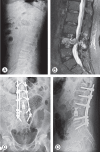Palliative Posterior Instrumentation versus Corpectomy with Cage Reconstruction Treatment for Thoracolumbar Pathological Fracture
- PMID: 30481977
- PMCID: PMC6454292
- DOI: 10.31616/asj.2018.0153
Palliative Posterior Instrumentation versus Corpectomy with Cage Reconstruction Treatment for Thoracolumbar Pathological Fracture
Abstract
Study design: Single-center, retrospective cohort study.
Purpose: We aimed to evaluate and compare the clinical outcomes in patients who underwent palliative posterior instrumentation (PPI) versus those who underwent corpectomy with cage reconstruction (CCR) for thoracolumbar pathological fracture.
Overview of literature: The requirement for anterior support after corpectomy has been emphasized in the treatment of pathological fractures of the vertebrae. However, for patients with a relatively short life expectancy, anterior reconstruction may not be required and posterior instrumentation alone may provide adequate stabilization.
Methods: A total of 43 patients with metastases of the thoracolumbar spine underwent surgery in the department of orthopaedic and traumatology of Istanbul University Faculty of Medicine from 2003 to 2016. Surgical outcomes were assessed on the basis of survival status, pre- and postoperative pain, complication rate, and operation time.
Results: PPI was performed for 22 patients and CCR was performed for 21 patients. In the PPI group, the follow-up period of the five surviving patients was 32 months. The remaining 17 patients died with a mean survival duration of 12.3 months postoperatively. In the CCR group, the five surviving patients were followed up for an average of 14.1 months. The remaining 16 patients died with a mean survival duration of 18.7 months postoperatively. No statistically significant difference (p=0.812) was noted in the survival duration. The Visual Analog Scale scores of the patients were significantly reduced after both procedures, with no significant difference noted on the basis of the type of surgical intervention (p>0.05). The complication rate in the CCR group (33.3%) was higher compared with that in the PPI group (22.7%); however, this difference was not noted to be statistically significant (p=0.379). The average operation time in the PPI group (149 minutes) was significantly shorter (p=0.04) than that in the CCR group (192 minutes).
Conclusions: The PPI technique can decompress the tumor for functional improvement and can stabilize the spinal structure to provide pain relief.
Keywords: Corpectomy; Expandable cage; Palliative surgery; Pathological fracture; Spinal metastases.
Conflict of interest statement
No potential conflict of interest relevant to this article was reported.
Figures



Similar articles
-
Comparison of mini-open anterior corpectomy and posterior total en bloc spondylectomy for solitary metastases of the thoracolumbar spine.J Neurosurg Spine. 2012 Oct;17(4):271-9. doi: 10.3171/2012.7.SPINE111086. Epub 2012 Aug 10. J Neurosurg Spine. 2012. PMID: 22881038
-
Palliative transpedicular partial corpectomy without anterior vertebral reconstruction in lower thoracic and thoracolumbar junction spinal metastases.J Orthop Surg Res. 2015 Jul 17;10:113. doi: 10.1186/s13018-015-0255-z. J Orthop Surg Res. 2015. PMID: 26183322 Free PMC article.
-
Single-stage posterior corpectomy and expandable cage placement for treatment of thoracic or lumbar burst fractures.Spine (Phila Pa 1976). 2009 Jan 1;34(1):E33-40. doi: 10.1097/BRS.0b013e318189fcfd. Spine (Phila Pa 1976). 2009. PMID: 19127146
-
Two in vivo surgical approaches for lumbar corpectomy using allograft and a metallic implant: a controlled clinical and biomechanical study.Spine J. 2006 Nov-Dec;6(6):648-58. doi: 10.1016/j.spinee.2006.04.028. Epub 2006 Oct 11. Spine J. 2006. PMID: 17088195
-
Successful short-segment instrumentation and fusion for thoracolumbar spine fractures: a consecutive 41/2-year series.Spine (Phila Pa 1976). 2000 May 1;25(9):1157-70. doi: 10.1097/00007632-200005010-00018. Spine (Phila Pa 1976). 2000. PMID: 10788862 Review.
Cited by
-
Efficacy of Total En Bloc Spondylectomy versus Stereotactic Ablative Radiotherapy for Single Spinal Metastasis.Cancers (Basel). 2023 Nov 22;15(23):5518. doi: 10.3390/cancers15235518. Cancers (Basel). 2023. PMID: 38067223 Free PMC article.
References
-
- Sciubba DM, Petteys RJ, Dekutoski MB, et al. Diagnosis and management of metastatic spine disease: a review. J Neurosurg Spine. 2010;13:94–108. - PubMed
-
- Kostuik JP, Errico TJ, Gleason TF, Errico CC. Spinal stabilization of vertebral column tumors. Spine (Phila Pa 1976) 1988;13:250–6. - PubMed
-
- Hussein AA, El-Karef E, Hafez M. Reconstructive surgery in spinal tumours. Eur J Surg Oncol. 2001;27:196–9. - PubMed
-
- King GJ, Kostuik JP, McBroom RJ, Richardson W. Surgical management of metastatic renal carcinoma of the spine. Spine (Phila Pa 1976) 1991;16:265–71. - PubMed
-
- Weigel B, Maghsudi M, Neumann C, Kretschmer R, Muller FJ, Nerlich M. Surgical management of symptomatic spinal metastases: postoperative outcome and quality of life. Spine (Phila Pa 1976) 1999;24:2240–6. - PubMed
LinkOut - more resources
Full Text Sources
Research Materials

